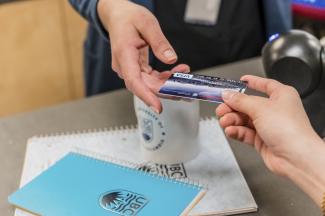Money and finances have a significant impact on how we get to live our lives.

We define wellbeing as “A positive state, where you can reach your full potential in life” and finances plays an influential role in that – naturally we attached a lot of emotion to it.
In Canada, 38% of people rank money as their greatest source of stress and this includes managing the increases in the cost of living, dealing with debts, and saving for long- and short-term goals. With a lot of external uncertainty, brought on by emerging COVID-19 variants, new geopolitical tensions, and inflation, finding ways to increase our financial literacy and money management skills is more important than ever.
If this all feels a little overwhelming, the good news is it is never too late to start to learn and evaluate your own financial wellbeing and literacy. In this edition of Health UBC, we take a look at a few ways you can access support to improve your financial wellbeing. We share a few upcoming events, look at some financial wellbeing supports through our EFAP, and we look at the long-term approach to financial security with some help from the pension office.
Understand your relationship with money and finances
Before you rush off to read those stories and attend those events, we wanted to take a moment to help understand financial literacy. One of the pivotal aspects of understanding financial literacy is determining what financial wellbeing looks like to you. It is helpful to first understand your own emotional relationship to money and finances.
The way we perceive financial security is largely dependent on our cultural backgrounds and our personal history with money and finances. For example, if you grew up in a multigenerational home, where your community valued taking care of yourself and numerous family members was values then having a safety net or being financially secure could play a role in your relationship with finances. You may have come from a household of abundance or scarcity – these formative years and your experiences around finances will have had an impact on what financial security looks like to you.
Rather than jumping ahead to discuss what we should be doing with our finances, stop for a moment and assess your thought patterns, behaviours and emotions related to money. One way you might like to do this is by taking financial wellbeing assessments through our EFAP platform LifeWorks. To access the finance assessment (which is completely confidential) follow these steps:
-
Head over to LifeWorks and login
-
Take a look at our EFAP page, if you need help accessing LifeWorks
-
-
Navigate to Wellness in the top navigation, and then select “Assessments”
-
Choose the Financial Total Wellbeing Assessment and fill in the short questionnaire
-
If you are already logged in you can go straight to the Total Wellbeing Assessment page, here.
-
This assessment is a good place to start on your journey to financial wellbeing.
Define what financial health looks like
With this insight to hand, you can now begin to define what financial wellbeing means to you and set your goals accordingly. Thinking about financial wellbeing often involves setting goals for what you can accomplish now and what you can work on to make it a part of your larger financial strategy.
In our work as health promoters whether we are talking about self-care (which financial wellbeing is a significant part of) or positive coping, we know that goal setting is important to make progress. According to research, goal-setting can literally alter the structure of your brain so that you perceive and behave in ways that will cause you to achieve those goals. Part of this is having strong emotional resonance related to your relationship with money and finances – think about your upbringing, your culture, and even the results of your financial wellbeing assessment to get a good handle on how your emotions affect your financial wellbeing. We also recommend utilizing SMART goals and/or WOOP goals to set yourself up for success.
While good money management skills are not necessarily complicated, it is the psychological and emotional aspects of managing our finances that can have the biggest effect on our ability to take financial control. Be sure to be compassionate with yourself and seek support.
Truelove Twumasi-Afriyie
References:
2020 Financial Stress Index. https://fpcanada.ca/docs/default-source/news/financial-stress-survey.pdf
Cole, S., Balcetis, E., & Zhang, S. (2013). Visual perception and regulatory conflict: Motivation and physiology influence distance perception. Journal of Experimental Psychology: General, 142(1), 18–22. https://doi.org/10.1037/a0027882
Locke, E. A., Shaw, K. N., Saari, L. M., & Latham, G. P. (1981). Goal setting and task performance: 1969–1980. Psychological Bulletin, 90(1), 125–152. https://doi.org/10.1037/0033-2909.90.1.125
Stuifbergen, A. K., Becker, H., Timmerman, G. M., & Kullberg, V. (2003). The use of individualized goal setting to facilitate behavior change in women with multiple sclerosis. Journal of Neuroscience Nursing, 35(2), 94-101.
https://www.inc.com/geoffrey-james/what-goal-setting-does-to-your-brain…
Posted in Articles
Tagged
- HR
- Healthy UBC